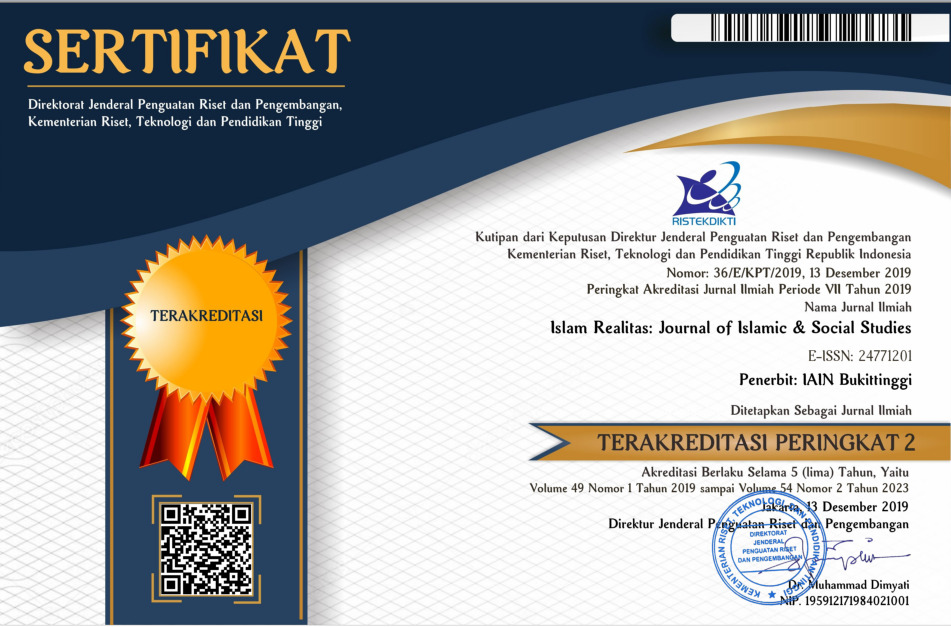The Transformation of Islamic Political Identity in The Countryside of Banyuwangi Through Osing Culture in 1970-2005
Downloads
This research examines why local identity building was conducted in Osing village, Banyuwangi Regency, East Java, and how this identity was initiated and invested by actors who have power using Islamic political identity. To respond to these questions, this research used the historical method by utilizing primary and secondary sources, such as official archive in form of decrees, interview with historical actors, and various references such as books, journals, and newspapers. This research findings are the following: Osing’s identity was a deliberate blueprint and not a natural continuity. This construction involved cultural practitioners, journalists, artists, intellectuals, traditional figures, and national administrators. Osing’s identity construction, transformation, negotiation, and mobility are the site of the contention of various interest. The attempt of creating a sympathetic and caring reputation of Osing culture represented by almost all of Banyuwangi regent continued from the New Order era until the post-Reformation era, despite various paradigm shifts. This needs to be interpreted as efforts to build identity and not just to eliminate the stigma attached. It has had an impact on political support and legitimacy in Banyuwangi, especially Osing Kemiren Village.
Books
Pranoto, ‘Gandrung Dalam Identitas Kelokalan’, in Seminar Kebudayaan Banyuwangi (Banyuwangi: Dewan Kesenian Blambangan, 2002).
Ridwan Kristianto, ‘Demo Menuntut Turunya Bupati Banyuwangi Mendapat Dukungan Para Kiai NU’, Jawa Pos (Surabaya, 1998).
Sadu Wasistono, Desentralisasi, Demokrasi, Dan Pembentukan Good Governance (Jakarta: LIPI Press, 2004).
Sri Margana, Outsiders and Stigma: Reconstruction of Local Identity in Banyuwangi (Singapore: NUS Press, 2015).
Sukamdi & Setiadi, State-Created Socio-Cultural Poverty: Lesson from Some Micro Studies (Singapore: Institute of Southeast Asian Studies, 2003).
Sutoro Eko, Meletakkan Desa Dalam Desentralisasi dan Demokrasi (Yogyakarta: Pustaka Pelajar, 2006).
Taufik Firmanto, Suku Using: Perspektif Etnografi, Sosial, Hukum, dan Budaya (Malang: Intelegensia Media, 2019).
Titik Maslikatin, Edy Hariyadi, dan Heru S. P Saputra, ‘Sastra Using: Tafsir Lokalitas dalam Konteks Perkembangan Zaman’, Jember University Press, 1 (2020).
Yulitin Sungkowati, ‘Kerudung Santet Gandrung: Simbol Perlawanan terhadap Kaum Santri Banyuwangi’, Diksi, 14 (2007).
Documents
DPD Golongan Karya, Surat Keputusan Dewan Pimpinan Daerah Tingkat II Nomor 042/DPD/-II/SGK/XI (Banyuwangi, 1976).
———, Surat Keputusan Dewan Pimpinan Daerah Tingkat II Nomor 140/DPD/GK-BWI/A/XII, 1994, p. 1
———, Surat Keputusan Dewan Pimpinan Daerah Tingkat II Nomor A-26/DPD/GK-BWI/IV, 1994.
DPD PDI, Surat Keputusan Dewan Pimpinan Daerah Tingkat I Nomor 235/KPTS/DPD/VI, 1987.
Kantor Desa Kemiren, Hasil Suara Dalam Pemilihan Kepala Desa 1989 (Banyuwangi, 1989).
———, Hasil Suara Dalam Pemilihan Kepala Desa 1999 (Banyuwangi, 1999).
———, Monografi Desa Kemiren Dalam Angka 2004 (Banyuwangi: Kantor Desa Kemiren, 2004).
———, Pendataan Profil Desa (PPD) Kemiren (Banyuwangi: Kantor Desa Kemiren, 2000).
———, Pendataan Profil Desa (PPD) Kemiren (Banyuwangi: Kantor Desa Kemiren, 2005)
Kemiren, Kantor Desa, Nota Dana Iuran Masyarakat (Banyuwangi, 2003).
Negara Kesatuan Republik Indonesia, Undang-Undang Nomor 05 Tahun 1974 Tentang Pemerintahan Desa, 1974.
———, Undang-Undang Nomor 05 Tahun 1979 Tentang Pemerintahan Desa, 1979.
Abdullah Fauzi, ‘Bupati Umumkan Bangun Rencana Desa Adat Using’, Radar Banyuwangi (Banyuwangi, 1995).
———, ‘Gubernur Undang Tokoh Adat Se-Banyuwangi’, Radar Banyuwangi (Banyuwangi, 15 April 1995).
———, ‘Wacana Desa Using Undang Tokoh Masyarakat Di Pendopo’, Radar Banyuwangi (Banyuwangi, 1995).
Carolyn D’Cruz 2008. Identity Politics in Deconstruction: Calculating with the Incalculable. Hampshire: Ashgate Publishing Limited.
Clifford Geertz, Abangan, Santri, Priyayi Dalam Masyarakat Jawa (Jakarta: Pustaka Jaya, 1989)
Henk Schulte Nordholt & Gerry van Klinken, Politik Lokal Di Indonesia (Jakarta: Yayasan Obor, 2009).
Ikwan Setiawan, Albert Tallapessy, Andang Subaharianto, Politik Identitas Etnis Pasca Reformasi (Jember: Unej Press, 2015).
Kuntowijoyo, Metodologi Sejarah (Yogyakarta: Tiara Wacana Yogya, 2003).
Kurniawati Hastuti Dewi, Indonesian Women and Local Politics. Islam, Gender and Networks in Post-Suharto Indonesia (Singapore: NUS Press, 2015).
Latif Kusairi, ‘Ontran-Ontran Demokrasi Kekerasan Dengan Isu Dukun Santet di Banyuwangi 1998-1999’ (Universitas Gadjah Mada, 2015).
Novi Anoegrajekti, Kesenian Using: Resistensi Budaya Komunitas Pinggir dalam Kebijakan Kebudayaan di Masa Orde Baru (Jakarta: PMB-LIPI, 2001).
———, ‘Nyanyian Gandrung: Membaca Lokalitas dalam Keindonesiaan’, in Seminar Internasional HISKI (Solo: Seminar Internasional HISKI, 2006).
———, Pengembangan Gandrung Banyuwangi dalam Rangka Penguatan Aset Budaya dan Identitas Lokal (Jember, 2009).
———, Potensi Budaya Using dan Industri Kreatif (Yogyakarta: Penerbit Ombak, 2018)
Journals
Ben Arps, ‘Using Kids and the Banners of Blambangan: Ethnolinguistic Identity and the Regional Past as an Ambient Theme in East Javanese Town’, Wacana, 11 (2009).
Chancal Kumar, ‘Multiculturalism in a Global Society: Minority Rights and Justice’, Research on Humanities and Social Science, 1 (2011).
Floya Anthias, ‘Where do I belong?: Narrating collective identity and translocational positionality’, Ethnicities, 2 (2002).
F. W. Riggs, ‘Turmoil among Nations, A Conceptual Essay: Ethnonationalism, Authoritarianism, Anarchy, and Democracy’, International Studies Association, 4 (2004).
Hasan Ali, ‘Kata Dan Predikat Using’, Majalah Budaya Jejak , March 2003).
I. G. Krisnadi, ‘Amuk Massa Banyuwangi 1965’, Ilmu Pengetahuan Sosial, 7 (2007).
Ikwan Setiawan, ‘Transformasi Masa Lalu Dalam Nyanyian Masa Kini: Hibridasi Dan Negosiasi Lokalitas Dalam Musik Populer Using’, Kultur, 2 (2007).
M. A. Ackelberg, ‘Identy Politics, Political Identities: Thoghts Toward a Multicultural Politics’, Journal of Women Studies, 16, (1996).
M. E. Gimenez, ‘With a little class: A critique of identity politics’, Ethnicities, 6. (2006).
Nankyung Choi, ‘Democracy and Patrimonial Politics in Local Indonesia’, Journal Southeast Asia Program Publications at Cornell University, 10 (2009).
Nawir, Muhammad, and Sam’un Mukramin, ‘Identitas Etnis dalam Ranah Politik’, Phinisi Integration Review, 2 (2019).
Novi Anoegrajekti, ‘Kontestasi dan Representasi Identitas Using’, Humaniora, 1 (2011).
Panitia Pemungutan Suara, Hasil Suara Pemilu di Desa Kemiren Tahun 1977 dan 1982 (Banyuwangi, 1982).
———, Hasil Suara Pemilu di Desa Kemiren Tahun 1987 (Banyuwangi, 1987).
Pemerintah Daerah Kabupaten Banyuwangi, Surat Keputusan Bupati Nomor 371 (Banyuwangi, 2002).
Pemerintah Tingkat II, Surat Keputusan Pemerintah Daerah Tingkat II Nomor 401 Penetapan Desa Using di Kabupaten Daerah Tingkat II Banyuwangi, 1996.
———, Surat Keputusan Pemerintah Daerah Tingkat II Nomor Um/1968/50 Pembinaan dan Pelestarian Kesenian dan Kebudayaan Using di Kabupaten Daerah Tingkat II Banyuwangi, 1970.
Interviews
Bambang Sugiharto, ‘Wawancara’ (Banyuwangi, 2021).
Hasnan Singodimayan, ‘Wawancara’ (Banyuwangi, 2021).
Joni Subagio, ‘Wawancara’ (Banyuwangi, 2021)
Jumhari, ‘Wawancara’ (Banyuwangi, 2021)
Sahunik, ‘Wawancara’ (Banyuwangi, 2021).
Samsul Handoko, ‘Wawancara’ (Banyuwangi, 2021).
Setyo Her Fendi, ‘Wawancara’ (Banyuwangi, 2021).
Authors who publish with this journal agree to the following terms:
- Authors retain copyright and grant the journal right of first publication with the work simultaneously licensed under a Creative Commons Attribution License that allows others to share the work with an acknowledgment of the work's authorship and initial publication in this journal.
- Authors are able to enter into separate, additional contractual arrangements for the non-exclusive distribution of the journal's published version of the work (e.g., post it to an institutional repository or publish it in a book), with an acknowledgment of its initial publication in this journal.
- Authors are permitted and encouraged to post their work online (e.g., in institutional repositories or on their website) prior to and during the submission process, as it can lead to productive exchanges, as well as earlier and greater citation of published work (See The Effect of Open Access).









